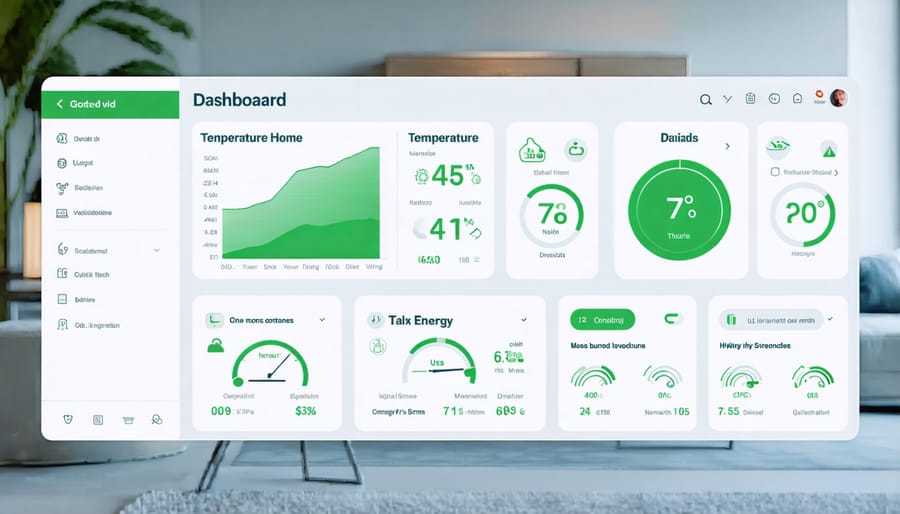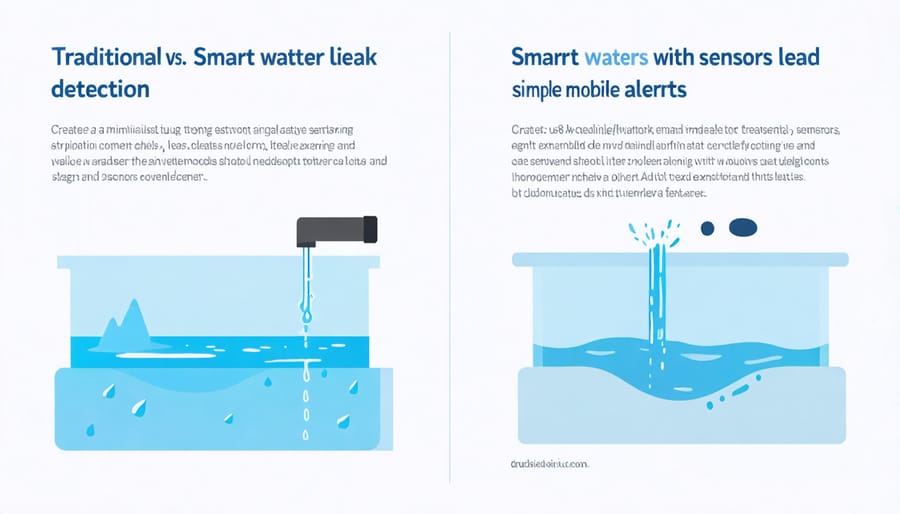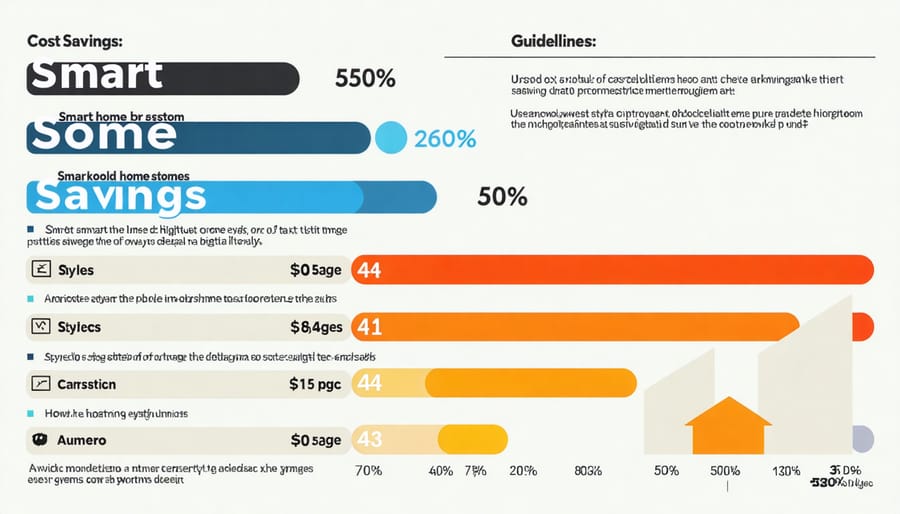Transform your home maintenance routine by integrating smart home systems that monitor, alert, and maintain critical components automatically. Install smart water leak detectors under sinks and near appliances to prevent costly water damage before it occurs. Set up automated HVAC maintenance schedules through connected thermostats to optimize energy efficiency and extend system life. Connect smart smoke detectors and carbon monoxide monitors to your phone for real-time safety alerts, even when you’re away.
Today’s home maintenance isn’t about remembering endless tasks and schedules – it’s about leveraging technology to protect your investment while simplifying your life. Smart sensors, automated routines, and connected devices work together to detect issues early, reduce energy waste, and maintain your home’s systems with minimal effort. Whether you’re a tech enthusiast or simply seeking peace of mind, modernizing your home maintenance approach can save thousands in preventive care while protecting what matters most.
Let’s explore how to transform your traditional maintenance checklist into an intelligent, automated system that works around the clock to keep your home running smoothly and efficiently.
Essential Smart Home Maintenance Systems
Smart HVAC Monitoring
Modern climate control has never been smarter, thanks to the evolution of smart HVAC monitoring systems and intelligent thermostats. These devices do more than just adjust your home’s temperature – they learn your preferences, adapt to your schedule, and help optimize energy usage throughout the day.
Smart thermostats like Nest or Ecobee can be controlled remotely through your smartphone, allowing you to adjust settings even when you’re away. They track your energy consumption patterns and provide detailed reports, helping you identify opportunities to reduce your utility bills. Many models even send alerts when it’s time to change filters or schedule maintenance, taking the guesswork out of HVAC care.
What makes these systems truly revolutionary is their ability to integrate with other smart home devices. For instance, they can work with your smart blinds to manage natural heat gain, or coordinate with occupancy sensors to adjust temperatures in specific rooms. Some advanced systems even monitor humidity levels and air quality, ensuring your home’s environment stays perfectly balanced for comfort and health.
Remember to choose a system that’s compatible with your existing HVAC setup and offers the features that matter most to your lifestyle.

Water Leak Detection Systems
Water leak detection systems are one of the smartest investments you can make for your home’s protection. These clever devices use advanced sensors to monitor your water usage patterns and detect even the smallest leaks before they become major problems. Place sensors near washing machines, water heaters, and under sinks to get instant alerts on your smartphone when moisture is detected.
Most smart water monitors attach directly to your main water line and can automatically shut off your water supply if they detect unusual flow patterns or potential pipe bursts. This feature alone can save thousands in potential water damage repairs. Some systems even provide detailed insights about your water consumption, helping you spot inefficiencies and reduce your monthly bills.
For maximum protection, look for systems with multiple sensors and compatibility with your existing smart home setup. While the initial investment typically ranges from $200-500, the peace of mind and potential savings make these systems well worth considering for any modern home.
Smart Security Maintenance
Keeping your smart security systems in top condition is crucial for your home’s safety. Start with a monthly check of all cameras, sensors, and door locks. Clean camera lenses with a microfiber cloth and ensure motion sensors are free from dust and cobwebs. Test your backup batteries quarterly and replace them annually, even if they seem fine.
Don’t forget to update your security system’s software regularly – these updates often include critical security patches. Check your mobile app notifications weekly to ensure you’re still receiving alerts properly. For doorbell cameras, clean the button mechanism monthly to prevent stuck buttons and test the two-way audio.
Consider setting up automated maintenance reminders through your home automation hub. Review recorded footage storage limits monthly and clear unnecessary clips to maintain optimal system performance. If you notice any unusual behavior from your devices, don’t wait – contact your security provider immediately.

Automating Regular Maintenance Tasks
Scheduling and Reminders
Keeping up with home maintenance tasks can be overwhelming, but smart home technology makes it easier than ever to stay on top of your routine. By setting up automated schedules and reminders, you’ll never miss important maintenance tasks again.
Start by creating a digital maintenance calendar using your smart home hub or a dedicated home maintenance app. Most smart home systems allow you to set recurring tasks for daily, weekly, monthly, and annual maintenance items. For example, you can schedule monthly reminders to replace HVAC filters, quarterly notifications for checking smoke detector batteries, and annual alerts for professional system inspections.
Take advantage of sensor-based automation to make maintenance even more hands-off. Smart water leak detectors can alert you immediately when they sense moisture, while HVAC systems can notify you when air quality drops or filters need changing. Many modern appliances even come with built-in maintenance monitoring that sends notifications directly to your phone when service is needed.
Consider setting up zones in your home and assigning specific maintenance tasks to each area. This helps you organize and track maintenance needs more effectively. For instance, create separate schedules for indoor tasks (like filter changes and appliance maintenance) and outdoor tasks (such as gutter cleaning and lawn care).
Pro tip: Link your maintenance schedule to your smart home’s voice assistant. This allows you to quickly check upcoming tasks or mark completed items hands-free. You can also set up maintenance reminders to appear on your smart displays throughout the house, ensuring the whole family stays informed about household upkeep needs.
Remember to regularly review and adjust your maintenance schedule based on seasonal changes and your home’s specific needs. A well-maintained smart home runs more efficiently and can help prevent costly repairs down the line.
Smart Diagnostics
Smart sensors and diagnostic tools are revolutionizing how we maintain our homes, making it easier than ever to catch potential issues before they become major problems. Think of these devices as your home’s early warning system, constantly monitoring various aspects of your living space to keep everything running smoothly.
Water leak sensors, for instance, can detect moisture in vulnerable areas like under sinks, near washing machines, or around water heaters. These small but mighty devices send instant notifications to your smartphone when they detect even the smallest amount of water, potentially saving you thousands in water damage repairs.
Temperature and humidity sensors strategically placed throughout your home can alert you to conditions that might lead to mold growth or affect your HVAC system’s efficiency. Some smart thermostats go beyond just controlling your home’s temperature – they can actually diagnose potential HVAC issues by monitoring system performance and runtime patterns.
For electrical systems, smart circuit monitors can track power consumption patterns and identify potential electrical issues before they become hazardous. These devices can detect everything from overloaded circuits to failing appliances based on their power usage signatures.
Air quality monitors are another valuable addition to your smart diagnostic arsenal. They can detect harmful pollutants, excessive CO2 levels, and even warn you when it’s time to change your HVAC filters.
To get started with smart diagnostics, focus on your home’s most vulnerable areas first. Begin with basic water and temperature sensors, then gradually expand your system based on your specific needs. Remember to choose devices that integrate with your existing smart home platform for seamless monitoring and notifications.
Cost-Effective Smart Maintenance Solutions
Entry-Level Smart Systems
Getting started with smart home maintenance doesn’t have to break the bank or require a complete home overhaul. Several affordable, entry-level devices can make a significant difference in how you monitor and maintain your home.
Smart water leak detectors are an excellent first investment, typically costing between $30-50. Place these small sensors near washing machines, water heaters, or under sinks to receive instant alerts on your phone if water is detected, potentially saving thousands in water damage repairs.
Smart smoke and carbon monoxide detectors are another crucial addition, ranging from $50-100. Unlike traditional alarms, these devices send notifications to your phone even when you’re away from home, providing peace of mind and enhanced safety.
For energy management, start with smart plugs ($15-25 each) to monitor electricity usage and automatically shut off devices that waste power. Pair these with a few smart bulbs ($10-20 each) to create automated lighting schedules and reduce energy consumption.
A smart thermostat ($100-200) might seem like a bigger investment, but it typically pays for itself within two years through reduced energy bills. These devices learn your schedule and automatically adjust temperatures for optimal comfort and efficiency.
Begin with one or two devices that address your most pressing maintenance concerns, then gradually expand your smart system as you become more comfortable with the technology and see tangible benefits in your home maintenance routine.
Long-Term Savings Strategy
Investing in smart home maintenance systems might seem like a significant upfront cost, but the long-term savings can be substantial. By implementing energy-saving smart upgrades, homeowners typically see a return on investment within 2-3 years through reduced utility bills and prevention of costly repairs.
Smart thermostats, for instance, can save 10-15% on heating and cooling costs annually, while automated water leak detectors can prevent thousands in potential water damage. These systems also extend the life of your appliances and equipment through predictive maintenance, catching issues before they become expensive problems.
Consider the math: A basic smart home maintenance package might cost $1,000-2,000 initially, but can save $300-500 annually on utilities alone. Factor in the prevention of major repairs (average cost $3,000-5,000) and increased property value (3-5% on average), and the investment becomes increasingly attractive.
Beyond monetary benefits, smart maintenance systems save time and reduce stress. Automated monitoring and scheduling mean you’re no longer tracking maintenance tasks manually or worrying about forgotten upkeep. This convenience, combined with the peace of mind from 24/7 monitoring, makes smart home maintenance a worthwhile investment for the modern homeowner.

Integration and Troubleshooting
Compatible Systems
When setting up your smart home maintenance system, compatibility is key to ensuring all your devices work together seamlessly. Most modern smart home devices support popular protocols like Wi-Fi, Zigbee, or Z-Wave, but it’s essential to check compatibility before making any purchases.
Major smart home ecosystems like Amazon Alexa, Google Home, and Apple HomeKit offer extensive device support. If you’re already using one of these platforms, look for devices that specifically mention compatibility with your chosen ecosystem. Many manufacturers now design their products to work with multiple platforms, giving you more flexibility.
For maintenance-specific devices, such as smart water leak detectors, HVAC sensors, and automated filter systems, check if they can integrate with your existing home automation hub. Some devices may require additional bridges or hubs to connect to your system, so factor this into your planning.
Most smart maintenance devices also offer standalone apps, but the real power comes from integration. Look for devices that can trigger automated responses – for example, a water leak sensor that can automatically shut off your smart water valve, or an HVAC monitor that can adjust your thermostat based on filter condition.
Remember to check for regular firmware updates and ongoing support from manufacturers to ensure long-term compatibility and security.
Common Issues and Solutions
Even the most reliable smart home systems can experience hiccups from time to time. Here are some common issues you might encounter and their quick fixes:
Connection Problems: If your devices keep going offline, start by checking your Wi-Fi signal strength. Try moving your router closer to devices or installing a mesh network system. Sometimes, a simple router restart can resolve connectivity issues.
Battery-Related Issues: Many smart devices run on batteries and may behave erratically when power is low. Set up notifications to alert you when batteries need replacing, and keep spare batteries on hand for quick swaps.
App Glitches: When your smart home app isn’t responding properly, first ensure it’s updated to the latest version. If problems persist, try logging out, clearing the app cache, and logging back in. As a last resort, uninstall and reinstall the app.
Device Syncing Problems: If your devices aren’t communicating well with each other, check that they’re all on the same network and running compatible software versions. Sometimes, removing and re-adding devices to your network can resolve sync issues.
Remember that most smart home issues are software-related and can be resolved with a device restart or system refresh. If problems persist, consult your device manufacturer’s support resources or community forums for specific troubleshooting steps.
Smart home maintenance represents a significant leap forward in how we care for our living spaces. By embracing these technologies, homeowners can enjoy unprecedented convenience, efficiency, and peace of mind. The integration of smart sensors, automated systems, and mobile connectivity has transformed routine maintenance from a burden into a streamlined, proactive process.
Looking ahead, we can expect even more exciting developments in smart home maintenance. Artificial intelligence will become more sophisticated, offering predictive maintenance capabilities that can spot potential issues before they become problems. The Internet of Things (IoT) will continue to expand, creating more seamless connections between our home systems and maintenance routines.
As these technologies become more affordable and user-friendly, they’ll become increasingly accessible to the average homeowner. Whether you’re starting small with smart thermostats and water leak detectors or going all-in with a fully automated home maintenance system, the investment typically pays off through reduced utility bills, prevented damage, and increased home value.
Remember, smart home maintenance isn’t just about having the latest gadgets – it’s about creating a more efficient, comfortable, and sustainable living environment for you and your family.
